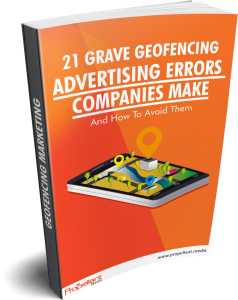Want a free copy of our new PDF “21 Grave Geofencing Advertising Errors Companies Make?” Just enter your email address for free access. BELOW IS AN EXCERPT FROM THE LIST

After running many geofencing advertising campaigns for agencies and direct clients, we’ve seen it all. Campaigns with bad geofencing locations. Campaigns simply paused and not even active. Audience pools that should reset every 1 week versus 30 days. Most enterprises expect to see campaigns built with precision and success, but there are still hiccups that can inhibit the success of programmatic geofencing campaigns.
In addition to the successes many organizations experience with geofencing advertising, it’s critical to consider the errors and pitfalls made in building geofencing campaigns in order to help prevent those same mistakes from happening in any future campaigns you run with any geofencing provider.
Not Thinking Through The Entire Customer Journey
Many advertisers as well as agencies do not think about the entire customer journey before building a geofencing campaign. It may sound hyperbolic, but many campaigns fail for this reason alone. We’ve had painters insist on geofencing highways. Dentists insist on geofencing an entire city (which defeats the purpose of geofencing), and even retailers geofence non competitor locations.
The key question we always ask is “where do the majority of my customers go before they come to me? And if they are served an ad, what are the chances they will inquire about my products or services? Why would they inquire about my services or products?” All of these questions are critical as they fall in line with understanding the customer journey….your customer’s journey before they make a decision to buy. This will inevitably help you identify the proper geofencing targets.
Being An Order Taker….Not A Strategist
Many geofencing providers will field phone calls from companies that simply give them a list of geofencing location targets, a budget, a website link, and requests that they simply launch a campaign. No strategy. No kickoff meeting. No discussions around the creative assets. No questions such as “hey, can you share a little more about your customer profile and where they hang out?”
Strategy built around these geofencing campaigns helps lead the campaigns to bearing fruit and overall success for clients. We built an entire strategy document around geofencing. It is that important. Ask clarifying strategic questions such as what sort of recency would you recommend for this campaign, who would you target, how long would you keep them in the audience pool? This will help you determine if you’re dealing with an order taker or a strategy centered enterprise that understands the nuances of your business or at minimum understands how to get to the core of who your audience truly is.
Picking The Wrong Locations To Geofence
The key question you should ask yourself is “where do my customers hang out before they come to me?” Another key question is “where do my customer hang out…period?” Many clients misconstrue the second question thinking they can target a location with simply users who fit the proper demographic. But just because they fit the demographic doesn’t mean they’re in the market looking to buy or likely to consider your offer. As a jewelry store, many of one’s customers may walk through the mall my store is located in, but that doesn’t mean the kids under 18 are likely to purchase jewelry from the store.
Consider where your most ideal customers are based in terms of the customer journey, and you will identify better geofencing locations to target.

